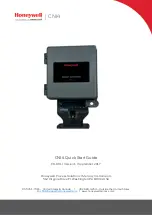
11
2. Enter Probe ID
This function will allow the user to identify the particular probe type or installation location with a unique,
4-digit tag number. Additionally, it allows the selection of correct probe element geometry, which is
necessary for the instrument’s calculation of metal loss and corrosion rate. Finally, it allows the user to
select the data collection rate. The operational sequence is as follows:
Once the “ENTER PROBE ID” function screen is located on the main menu, KEY 2 will give access to
the submenu. The initial screen of the submenu allows deletion of any stored data. Normally there will
be no data stored, since any useful data set will have been previously downloaded. If no useful data is
stored in the unit, press KEY 1 which will delete all existing data and give access to the Probe ID
screen. If useful data is stored, use KEY 2 to return to the main menu and download existing
data (p. 16) prior to proceeding.
The Probe ID screen allows you to insert a 4-digit identification number for the probe and/or monitoring
location. Each digit is selected with KEY 1, and individually entered with KEY 2.
When the fourth digit of the ID number is entered, the screen will automatically change to the element
identification screen.
The element identification screen shows the Probe ID number and a 5-6 digit/letter sequence that
identifies the probe element geometry and thickness. KEY 1 allows the user to scroll through the
element identifications, and KEY 2 will enter the appropriate element ID once it is located.
It should be noted that the variety of element geometries and thicknesses that is offered by
the various probe manufacturers tends to increase. Consequently it is possible, from time to
time, that the user may encounter a probe element style that is not included in the instrument
look-up table. In such a case, the user may select any of the element geometries in the table,
except wire, that has the same thickness as the element under consideration.
Upon entry of the probe element ID, the screen will automatically change to the data collection rate
screen. This allows the user to select the frequency with which the probe should be read. This can be
set in hourly increments from as high as once per hour to as low as once every 2,475 hours. The reading
frequency is set on the screen as days (two digits) and hours (two digits). The default reading is 1 per
hour. Each digit is selected by a KEY 1 scroll, and individually entered with KEY 2. Once the last hour
digit is entered, the next screen will be displayed which shows the reading frequency as entered, which
can then be accepted (KEY 2) or rejected (KEY 1). If accepted, the screen will revert to the “MEA-
SURE PROBE” function screen, and the user can proceed to the “START DATA LOGGING” func-
tion. If rejected, the screen will also revert to the “MEASURE PROBE” function screen, but the user is
Содержание MS3500E
Страница 2: ... ...
Страница 40: ...36 Figure 8 Element Selection Guide Element Life ...
Страница 41: ...37 Figure 9 Element selection guide response time ...















































